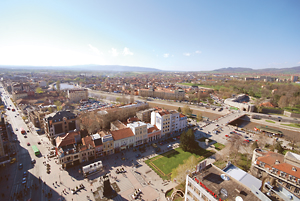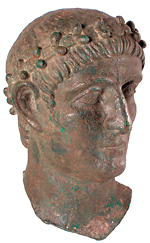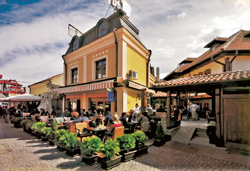 Visiting Visiting
NIŠ, IN THE GLOW OF CONSTANTINE’S TOWN, WHICH IS GETTING MORE ATTRACTIVE FOR DOMESTIC AND FOREIGN TOURISTS
New Rise of the Southern Capital
The 1700th anniversary of the Edict of Milan, legalizing Christianity in the Empire, brought by the Roman Emperor Constantine the Great will be celebrated in 2013 in Europe. The central place of the event will be three towns which are directly connected with the life of Constantine the Great: Niš (his native town), York (where he was proclaimed the Emperor in 306) and Trier (where he reigned). So, in 2013 Niš will be the centre of European attention. It will be a great chance both for Niš and Serbia
By: Goran Budimir
 It got its name after a river which is passing through it from the southeast and then empties into Južna Morava. All those who have controlled this town, during a history which lasted for millenniums, have derived its name from the name of the river. For the Celts, it was Navissos, the Romans called it Naisus, The Byzantine Nysos, the Germans Nissa, the Slavs Niš. Vilin grad. One of the oldest towns in Europe. The oldest traces are from neolith era, 4000-3000 B.C. (localities of Bubanj, Humska Čuka, and some younger ones of Gornja and Donja Vrežina, Trupale, Gornja Toponica). In the 8th century B.C. this was the border area between the Illyrians and the Thracians. In the 3rd century, the Celts have conquered the Illyrians, they took over the area and they gave a name to the town, with variations in different languages, which is remained to the present day. In the year of 75, during the Dardan War, Niš was conquered by the Romans. It got its name after a river which is passing through it from the southeast and then empties into Južna Morava. All those who have controlled this town, during a history which lasted for millenniums, have derived its name from the name of the river. For the Celts, it was Navissos, the Romans called it Naisus, The Byzantine Nysos, the Germans Nissa, the Slavs Niš. Vilin grad. One of the oldest towns in Europe. The oldest traces are from neolith era, 4000-3000 B.C. (localities of Bubanj, Humska Čuka, and some younger ones of Gornja and Donja Vrežina, Trupale, Gornja Toponica). In the 8th century B.C. this was the border area between the Illyrians and the Thracians. In the 3rd century, the Celts have conquered the Illyrians, they took over the area and they gave a name to the town, with variations in different languages, which is remained to the present day. In the year of 75, during the Dardan War, Niš was conquered by the Romans.
 From a never-ending list of important dates in the history of this town, we shall mention only a few. From a never-ending list of important dates in the history of this town, we shall mention only a few.
In the 3rd century of the new era, the future Roman Emperor Constantine was born here and raised here, one of the most famous emperors of the Roman Empire. Building his luxurious palace in Mediana, on the edges of present Niš, towards Niš Spa, his town and his homeland became famous far and wide.
In the 6th century, one half a century after the Huns have destroyed it during their campaign, Justinian I brought Niš his glow back, as a great renovator of the Empire.
In the end of the 12th century, in 1183, Stefan Nemanja joined Niš to his Serbia, intending to make it the capital. That never happened, but Niš was a great economic, cultural and strategic centre, until the fall of the medieval state into Turkish slavery. It was noted that in 1189, Stefan Nemanja met Fridrich I Barbarosa in Niš, making a new alliance.
In 1443, in the great battle of Nip, Duke Sibinjanin Janko (Janos Hunyadi) and the Serbian Despote Đurađ Branković conquered the Turks and liberate the town for a year. The new liberation and the renaissance had to be waited for 434 years! With the liberation form the Turkish slavery in 1878, Niš resurrected and began its modern development.
 ”Niš then stepped into the most important period of its history”, the chroniclers note. ”It became the second capital of modern Serbia. In Niš was the residence of King Milan and King Aleksandar Obrenović, the Prince’s Court, where they often spent their time, especially when meetings of the National Assembly of the Kingdom of Serbia were held in Niš.” ”Niš then stepped into the most important period of its history”, the chroniclers note. ”It became the second capital of modern Serbia. In Niš was the residence of King Milan and King Aleksandar Obrenović, the Prince’s Court, where they often spent their time, especially when meetings of the National Assembly of the Kingdom of Serbia were held in Niš.”
During World War I, from July of 1914 until October of 1915, Niš was the war capital of Serbia. The government held its meetings in the former building of the Hotel ”Ambasador” in Niš.
Many histories, chronicles and chronologies witness the fast development of Niš since the liberation until World War I, between world wars and after World War II. Although it suffered a lot, it was bombed 32 times only in World War II, but with great strength and vitality it healed its wounds quickly, raised and went further on the road of prosperity and development. Today, it is a modern town, which is quickly rising after tough years of economic sanctions, breakdown of the country and of the economy, back on the good road of the ”southern capital”.
THE GENESIS OF THE MODERN TOWN
 Travellers and chroniclers, more or less talented, called this town a gate, a crossroads, a connection, a museum, a treasury, an exciting modern town with great potentials and comparative advantages. Travellers and chroniclers, more or less talented, called this town a gate, a crossroads, a connection, a museum, a treasury, an exciting modern town with great potentials and comparative advantages.
– Niš really has a great geographic position and great comparative advantages for a good development of tourism – says Vladimir Jovanović, the Manager of the Tourist Organization of Niš, for National Review. – On only 30 kilometres of the town and its vicinities, great tourist potentials are gathered. We can easily see great opportunities for transit tourism (Corridor X), health tourism (Niš Spa and Topilo Spa), cultural and historic tourism (66 archaeological sites, 265 cultural sites), town and event tourism and business tourism (fairs, congresses, festivals, art colonies), excursion tourism (gorges of Sićevo and Jelašnica, Bojanine vode, Kamenički vis, Čegar, Oblačina, Mali Jastrebac), hunting and fishing tourism (Nišava, Oblačinsko Lake, Suva Mountain, Mali Jasterbac) and sport tourism. There are tourist resources which are to be activated and should get real valorisation (Cerjanka Cave, Topilo Spa, Planinsko hinterland, Zaplanje).
This beautiful modern town, with long memories and tradition, has a printed book since 1766 (Sinđelija of Archbishop Gavrilo), a Gymnasium since 1878, its first bank from 1881, the first railroad for Belgrade and the first edition of Niški vjesnik from 1884, the first modern company (Železnička radionica) from 1885. The Law of Establishing the Royal Serbian Academy was brought in Niš, in 1886. The first theatre ”Sinđelić” exists since 1887, and the National Library since 1889. The first movie was shown in 1897, and the first movie theatre started working in 1906. The literary magazine Gradina started being published in 1900 and the art colony Sićevo, created by the famous painter Nadežda Petrović, exists since 1905. The first power plant on Nišava River, near Sićevo, was built in 1908...
If you visit this town today, which is strongly recommended, you should check out the calendar of cultural, tourist and sport events that are taking place in this town, of which are mostly international.
UNDER AUSPICES OF THE EMPEROR
 The simplest guides of Niš will direct you to visit Mediana, the summer residence of Emperor Constantine the Great, five kilometres away from the town centre. Constantine spent a lot of his time in this luxurious antique complex; that is the place where he brought many important laws of the Empire in 315, 319, 324 and 334. Some people can still feel and recognize the spirit of place (genius loci) in this spacious field, they can close their eyes and see the palaces and the colonnades, the thermae and the temples, the marble canal which brings water from nearby healing springs all the way to the Emperor’s rooms... Then, they can open their eyes and learn again the lesson on transitoriness. You can see rich finding of Mediana and other Roman localities in the National Museum of Niš and in several publications of the museum. The simplest guides of Niš will direct you to visit Mediana, the summer residence of Emperor Constantine the Great, five kilometres away from the town centre. Constantine spent a lot of his time in this luxurious antique complex; that is the place where he brought many important laws of the Empire in 315, 319, 324 and 334. Some people can still feel and recognize the spirit of place (genius loci) in this spacious field, they can close their eyes and see the palaces and the colonnades, the thermae and the temples, the marble canal which brings water from nearby healing springs all the way to the Emperor’s rooms... Then, they can open their eyes and learn again the lesson on transitoriness. You can see rich finding of Mediana and other Roman localities in the National Museum of Niš and in several publications of the museum.
The Fortress of Niš, built by the Turks in the 18th century, on the basis of a Roman military camp and a Byzantine medieval fortification, is the best preserved object in the central part of the Balkans, and today it is one of the most popular symbols of Niš and a location that you should not miss. In the remains of the fortress, built by the best master of Constantinople and by local residents with unpaid labour, you can still see the arsenal, the Turkish bath, the powder plant, the post office... Today, those are art pavilions, galleries, cafes, restaurants, historic archives, a summer stage, the favourite place of the people of Niš and all guests of this town.
When you are in Niš, it is very pleasant to walk on the Square of King Milan or the Obrenović Street, the modern town centres, bright, cheerful, alive, which remind us of Mediterranean towns, their squares and corsos. It is also interesting to visit Kazandžijsko sokače, a preserved and protected part of the old town, built in the first half of the 18th century, now with modern items.
 In order to get to know the dramatic past of this town and give it some attention, fro the monuments of Niš, you should visit the Monument of Čegar, on the location where exactly 200 years ago (1809), on May 31st, during the First Serbian Uprising, Duke Sinđelić and his soldiers had a tough battle against three times more Turks. Near Ćele kula, which was built by the Turks from the skulls of the fallen Serbian heroes on Čegar, Alphonse Lamartine wrote in 1833: ”The Serbs should preserve this monument! It will learn their children how much the freedom of one nation is worth, showing them what is the price their father paid for it.” In order to get to know the dramatic past of this town and give it some attention, fro the monuments of Niš, you should visit the Monument of Čegar, on the location where exactly 200 years ago (1809), on May 31st, during the First Serbian Uprising, Duke Sinđelić and his soldiers had a tough battle against three times more Turks. Near Ćele kula, which was built by the Turks from the skulls of the fallen Serbian heroes on Čegar, Alphonse Lamartine wrote in 1833: ”The Serbs should preserve this monument! It will learn their children how much the freedom of one nation is worth, showing them what is the price their father paid for it.”
Of many monuments of sacral architecture and art, we should mention the two oldest ones: the Byzantine church from the 11th century and the Church of St. Panteleimon from the 12th century.
 – There are many possibilities for a tourist in Niš, many ways to make a beautiful, interesting, fulfilled stay in our town and its vicinities. On of our main goals is that Niš becomes a tourist destination for a longer stay, now being a good example for transit tourism – says Vladimir Jovanović, the Manager of the Tourist Organization of Niš. – We have a Greek and a Bulgarian consulate, and soon we will have a French, an American and a Russian cultural centre. Niš is now entering the centre of European interest. In 2013, Europe is planning to celebrate 1700 years since the Edict of Milan with many events and projects and besides Trier and York, Niš will be the centre of the event. It is a great honour and a great chance both for Niš and Serbia. – There are many possibilities for a tourist in Niš, many ways to make a beautiful, interesting, fulfilled stay in our town and its vicinities. On of our main goals is that Niš becomes a tourist destination for a longer stay, now being a good example for transit tourism – says Vladimir Jovanović, the Manager of the Tourist Organization of Niš. – We have a Greek and a Bulgarian consulate, and soon we will have a French, an American and a Russian cultural centre. Niš is now entering the centre of European interest. In 2013, Europe is planning to celebrate 1700 years since the Edict of Milan with many events and projects and besides Trier and York, Niš will be the centre of the event. It is a great honour and a great chance both for Niš and Serbia.
***
Stevan and Branko
From many great people who marked the cultural history of Niš, but Serbian culture in general, we must mention the writer Stevan Sremac and the poet Branko Miljković. You should read their biographies and their work, and you will realize their importance. And then, is you are once in Niš, you should follow their traces through town.
***
Obrenović dynasty
Niš is a town which has a great respect for the Obrenović dynasty. It can be seen by the monuments, holidays, names of important streets and squares... King Milan Obrenović is considered the liberator of Niš from a long Turkish slavery, in 1878. He was the main initiator of building the railroad Belgrade-Niš and the first passenger in the train (1884). During his reign, Niš became the second capital of Serbia, the Parliament meeting were held there, the King’s court was there. Milan’s son, the unfortunate last Obrenović, continued his father’s aims.
|
